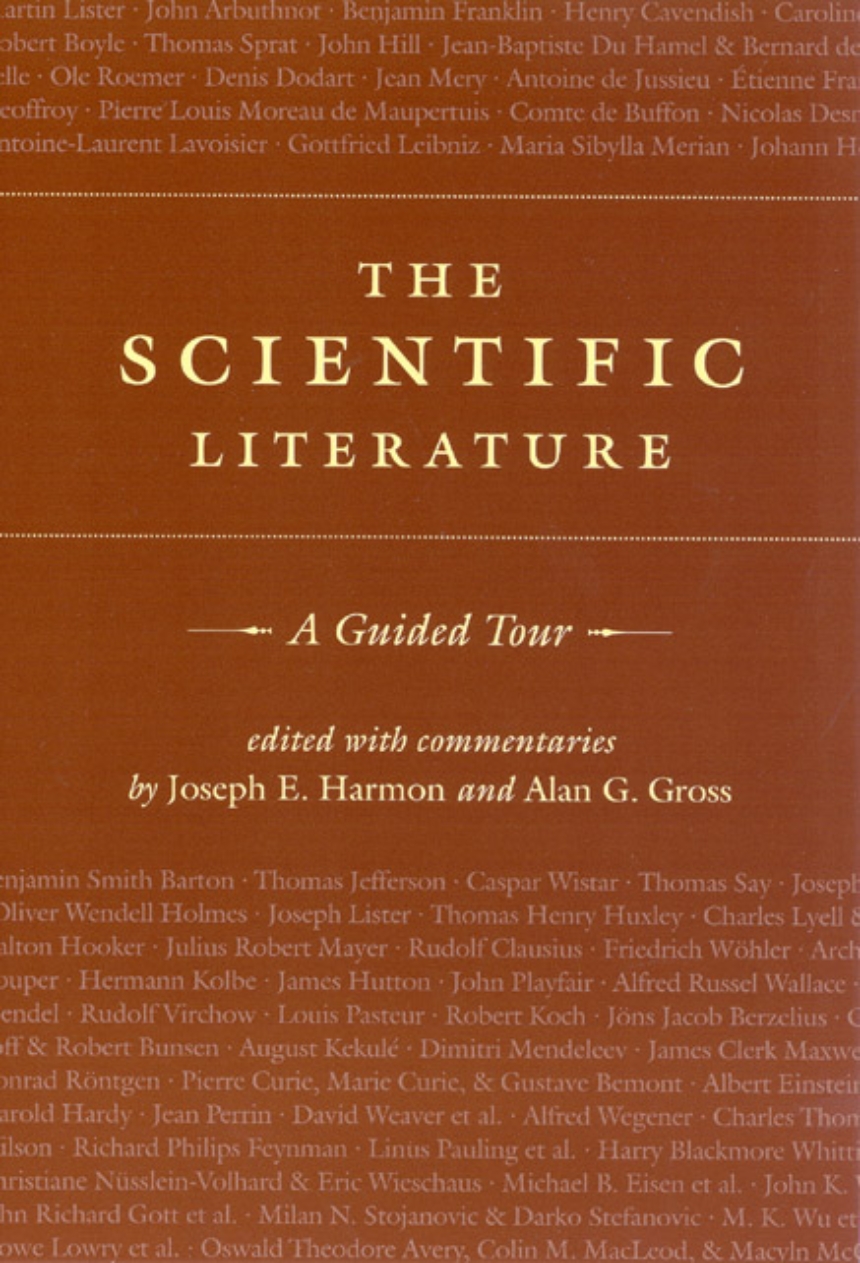The Scientific Literature
A Guided Tour
The scientific article has been a hallmark of the career of every important western scientist since the seventeenth century. Yet its role in the history of science has not been fully explored. Joseph E. Harmon and Alan G. Gross remedy this oversight with The Scientific Literature, a collection of writings—excerpts from scientific articles, letters, memoirs, proceedings, transactions, and magazines—that illustrates the origin of the scientific article in 1665 and its evolution over the next three and a half centuries.
Featuring articles—as well as sixty tables and illustrations, tools vital to scientific communication—that represent the broad sweep of modern science, The Scientific Literature is a historical tour through both the rhetorical strategies that scientists employ to share their discoveries and the methods that scientists use to argue claims of new knowledge. Commentaries that explain each excerpt’s scientific and historical context and analyze its communication strategy accompany each entry.
A unique anthology, The Scientific Literature will allow both the scholar and the general reader to experience first hand the development of modern science.
312 pages | 31 halftones, 27 line drawings | 6 x 9 | © 2007
History: History of Ideas
Literature and Literary Criticism: General Criticism and Critical Theory
Reviews
Table of Contents
Introduction
1. First English Periodical
Early Books and Letters
Robert Boyle—New experiments physico-mechanical (1660)
Robert Hooke—Micrographia (1665)
Antoni van Leeuwenhoek—Anatomy of fleas (1693)
Philosophical Transactions
Henry Oldenburg & Christiaan Huygens—Pendulum-watches at sea (1665)
Adrien Auzout—Apertures of object glasses (1665)
Henry Oldenburg—Transfusion (1667)
Robert Boyle—Experiments about respiration (1670)
Isaac Newton—Theory of light and colors (1672)
Isaac Newton—Answer to letter from Pardies (1672)
Mr. Toyard—Sieur Bernier’s flying machine (1681)
Martin Lister—English vegetables (1697)
John Arbuthnot—Argument for divine providence (1710)
Benjamin Franklin—Effects of electricity in paralytic cases (1758)
Henry Cavendish—Experiments on air (1784)
Caroline Herschel—New comet (1787)
On Early English Scientific Writing
Robert Boyle—Considerations Touching Experimental Essays (1661)
Thomas Sprat—History of the Royal Society (1667)
John Hill—Works of the Royal Society (1751)
2. First French Periodicals
Concerning the Royal Academy in Paris
Jean-Baptiste Du Hamel & Bernard de Fontenelle—History of the Royal Academy (1733)
Journal of the Learned
Anonymous—Letter written from Oxford (1665)
Anonymous—Review of Anatomical Description (1669)
Ole Roemer—Speed of light (1676)
Anonymous—Review of Principia (1688)
Memoirs of the Royal Academy of Sciences
Denis Dodart—History of plants (1676)
Jean Mery—Two fetuses enclosed in the same membrane (1693)
Antoine de Jussieu—Corispermum Hyssopifolium (1712)
Étienne François Geoffroy—Different relationships observed in chemistry (1718)
Pierre Louis Moreau de Maupertuis—The figure of the earth (1738)
Compte de Buffon—Conservation and re-establishment of forests (1739)
Nicolas Desmarest—Nature of prismatic basalt (1774) Antoine-Laurent Lavoisier—Combustion (1777)
Antoine-Laurent Lavoisier—Modern horizontal beds deposited by the sea (1789)
3. Internationalization and Specialization
German Literature
Gottfried Leibniz—Calculation of various dimensions of figures (1684)
Maria Sibylla Merian—Metamorphosis of insects (1705)
Johann Heinrich Lambert—Measurement of humidity (1769)
Anonymous—Review of Three Letters on Mineralogy (1789)
American Literature
Benjamin Smith Barton—American species of dipus (1799)
Thomas Jefferson—Bones of quadruped of the clawed kind (1799)
Caspar Wistar—Description of bones deposited by President (1799)
Thomas Say—North American insects of the genus Cicindela (1818)
Joseph Henry—Production of currents and sparks of electricity (1832)
Oliver Wendell Holmes—Contagiousness of puerperal fever (1843)
Joseph Lister—Antiseptic principle (1867)
Specialized Literature: Biology
Anonymous—Hibiscus Rosa Sinensis (1791)
T. H. Huxley—Review of Vestiges (1854)
Charles Lyell & J. D. Hooker—Papers by Darwin and Wallace (1858)
Specialized Literature: Physics
Julius Robert Mayer—Forces of inorganic nature (1842)
Rudolf Clausius—Nature of motion we call heat (1857)
Specialized Literature: Chemistry
Friedrich Wöhler—Alcoholic fermentation (1839)
Archibald Scott Couper—New chemical theory (1858)
Hermann Kolbe—Radical theory (1871)
4. Select Pre-modern Classics
Earth Science
James Hutton—Theory of the Earth (1788)
John Playfair—Account of James Hutton (1805)
Evolutionary Biology
Alfred Russel Wallace—Tendency of varieties to depart from the original (1858)
Gregor Mendel—Plant hybridization (1866)
Medical Science
Rudolf Virchow—Cellular pathology (1855)
Louis Pasteur—Germ theory (1880)
Robert Koch—Etiology of tuberculosis (1882)
Chemistry
Jöns Jacob Berzelius—Cause of chemical proportions (1813)
Gustav Kirchhoff & Robert Bunsen—Analysis by observation of spectra (1860)
August Kekulé—Composition of aromatics (1865)
Dimitri Mendeleev—Laws of the chemical elements (1869)
Physics
James Clerk Maxwell—Faraday’s lines of force (1855)
Wilhelm Conrad Röntgen—New kind of ray (1895)
Pierre Curie, Marie Curie, & G. Bemont—New, strongly radioactive substance (1898)
5. Equations, Tables, and Pictures
Equations
Albert Einstein—Does the inertia of a body depend on energy content? (1905)
G. H. Hardy—Mendelian proportions in mixed population (1908)
Tables
Jean Perrin—Brownian motion and molecular reality (1909)
David Weaver et al.—Endogenous immunoglobulin gene expression (1986)
Pictures
A. Wegener—Origin of continents (1912)
C. T. R. Wilson—Tracks of ionizing particles (1912)
R. P. Feynman—Space-time approach to quantum electrodynamics (1949)
L. Pauling et al.—Structure of proteins (1951)
H. B. Whittington—The enigmatic animal Opabinia regalis (1975)
Christiane Nusslen-Volhard & Eric Wieschaus—Mutations in Drosophila (1980)
Michael B. Eisen et al.—Genome-wide expression patterns (1998)
J. K. Webb et al.—Fine structure constant (2001)
J. Richard Gott et al.—Map of the universe (2003)
6. Organizing Scientific Arguments
Beginning
Milan N. Stojanovic & Darko Stefanovic—Deoxyribozyme-based molecular automata (2003)
M. K. Wu et al.—Superconductivity at 93 K (1987)
Middle
Oliver H. Lowry et al.—Protein measurement (1951)
Oswald T. Avery, Colin M. MacLeod, & Macyln McCarty—Transformation of pneumococcal types (1944)
End
Motoo Kimura—Evolutionary rate at molecular level (1968)
M. Gell-Mann—Model of baryons and mesons (1964)
Awards
The National Council of Teachers of English: NCTE Technical and Scientific Communications Award
Won
